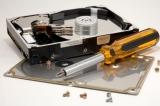
Top Ten Tips to Protect your Data
1. Do not store data in default directories like “My Computer”. This is the first place a Virus, Trojan or Worm will seek to infect.
2. Learn the IP addresses of your important favourites such as online banking. Websites are easy to clone, but IP addresses are much harder to disguise.
3. Partition your data. If you have your data, email databases and program files on separate partitions then the start-up or shutdown will not touch them in the event of failure.
4. Use a surge protector and do not overload power sockets. Unplug equipment when not in use. The majority of electronic problems are caused by power interruptions or surges.
5. Do not put your processor on the floor. The fan will suck in a lot more dust and the processor is liable to overheat much more quickly.
6. Do not move drives or computers whilst spinning. Always turn them off before moving them; otherwise they are much more liable to crash.
Using Solid State Drives (SSD) will lessen this concern.
7. Limit access to your data by setting up individual users and password protecting each individual’s data.
8. Uninstall unused software and user accounts. Each has the potential to allow an attacker access to the system.
9. Software vendors routinely issues updates or patches. These fix problems and vulnerabilities, so it is wise to keep your system up-to-date.
10. Ensure your firewall and anti-virus is suitable for the perceived threat and the value of your data. Consider encryption for mission critical data.

System Protection from E-Crime
Virus Attacks. These are only too easy to pick up from the internet. Change your Windows settings so that you can see the true file extensions. Never click on a file that ends in .exe or .pif or .vbs as these are files that launch programs and do not open any file attachments from people you don’t know.
Ensure you have adequate virus and spyware protection and that it is updated automatically. DO NOT store data in any default directories (eg My Documents) – this is the first place a virus will seek out. Use the scan facility regularly and heal any infected files. Rename directories logically and store them under the root and on a separate partition. Partitioning gives enormous advantages in file recovery and should be considered an essential precaution; however avoid installing separate operating systems on those partitions.
Worms. To avoid a worm infecting your address book and spreading, add a new contact called 000_. Where it prompts you to enter the new email address, type in WormAlert@alert.com. The “name” 000_ will be placed at the top of your address book as the first entry. This will be where the worm will start in an effort to send itself to all your friends, but when it tries to send itself to 000_ it will be undeliverable and the worm goes no further and your friends will not be infected. If an email cannot be delivered, you will be notified of this in your Inbox very quickly. Hence, if you ever get an email telling you that an email addressed to WormAlert@alert.com could not be delivered, you know right away that a worm has infected your system and you can take steps to get rid of it.
Wireless Security. Use a Wireless Access Point, Router or Gateway with built-in Security. Contrary to some beliefs, making your wireless network secure is straightforward. Most wireless devices are shipped with default security settings, which are never set up by users. Lock down your wireless network or you may be open to hackers.
Web Security. Learn the IP addresses of your favourite websites (especially if you are banking online). Websites can easily be cloned, but IP addresses are more difficult to sabotage. DO NOT ever click on links received from emails, these can easily be rooted through to rogue websites. Poor authentication procedures are opening organisations website to hijack. There are tools that will detect and clean your system, but preferably make sure that you have got the latest updates and patches for your operating system.

Diagnosing Hard Drive Problems
In this article we examine typical symptoms of hard drive failure and possible causes. What are the signs to look out for? While there are few sure-fire signs of impending disk failure there are some warning signals that give us the hint. Watch out for: disappearing files, very long wait while accessing files, files/folders whose contents appear to be strangely scrambled; reoccurring error messages while moving/copying/ deleting/creating files, and strange but frequent crashes of your O/S.
a. Hard drive is recognised, but grinds/scratches/clicks. Almost certainly a mechanical failure. Without opening the drive in a clean room, it is difficult to determine whether it is bearings, motor or heads. Try to keep it cool using a desk fan (DO NOT put in fridge or freezer) and copy your most critical data. You may have minutes before drive completely crashes.
b. Hard drive is NOT recognised and grinds/scratches/clicks. As in (a) above, but there is nothing the user can do without a full drive rebuild – seek specialist help.
c. PC powers but error message “cannot load operating system” or similar. Assuming there is not a problem with the computer itself (eg PSU), this suggests the boot sector is damaged. To recover the data, use specific data recovery software to repair the damage, or seek specialist help.
d. Hard Drive is NOT getting power. Almost certainly a PCB fault, but be aware this is often coupled with (a) above. Try swapping PCB (ONLY with identical part number, firmware revision and PCB number). If the user then experiences (a) above, disconnect power immediately.
e. Hard drive is vibrating. A very common problem with drives manufactured in China – the spindle bearings are seized. This will require a full strip down and at best, re-lubrication or at worst, bearings/spindle/motor replacement.
f. Hard drive is slow to respond/irregular crashes. Assuming that you have already cleaned up any unwanted processes or applications, scanned your disk for infections, defragmented, adjusted virtual memory etc its time to suspect drive failure. Back up data and run SMART test to determine drive performance – if in doubt, replace hard drive.
g. Data is garbled when opened or will not open from thumbnails. Probably logical problem from an infection, or bad sectors effecting specific files. Use specific file repair utility for that type of file extension.
When diagnosing hard drive problems, the rule is NOT to take any intrusive actions. This includes running CHKDSK, writing more files to the hard drive, using the internet etc. If you are going to run a disk utility, use software that takes an image .img of the hard disk surface before starting the repair/recovery process.
